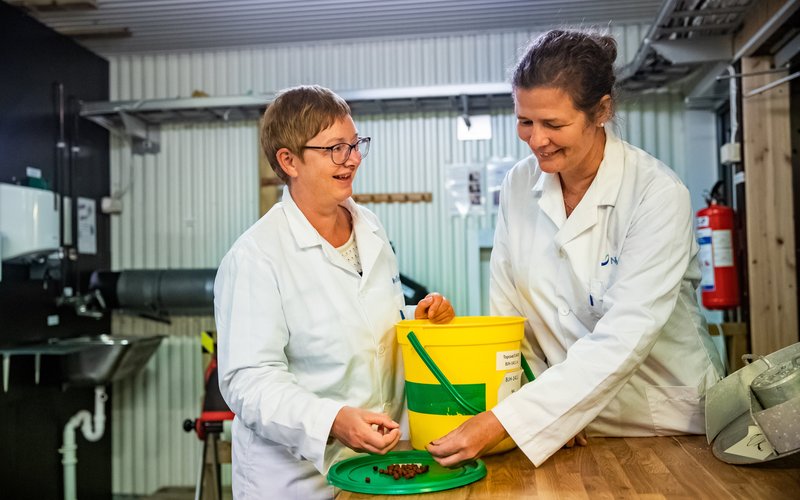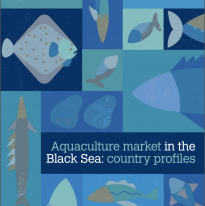Producers of Norwegian salmon feed have begun to use alternative ingredients, according to a Nofima report on raw materials for salmon and trout feeds in 2020. The report shows that the composition of feed for Norwegian farmed salmon is approximately the same as in the previous 2016 report but new ingredients, such as insect meal, single-cell protein, fermented products and microalgae, are now being used.
Turid Synnøve Aas, researcher in feed and nutrition at Nofima and main author of the report, said that “the report provides a basis for decision-makers on how we can use the resources and manage them in the best possible way.”
In 2020, new feed ingredients, such as insect meal, single-cell protein, fermented products and microalgae, accounted for a small proportion, only 0.4% of the total volume of salmon feed, or 8,000 tonnes in total. A total of 1.98 million tonnes of ingredients were used and 1.47 million tonnes of salmon and 0.9 million tonnes of rainbow trout were produced.
The Norwegian government has set a goal to increase salmon feed produced from Norwegian resources and that all feed should be from sustainable sources. “Feed is the largest source of greenhouse gas emissions in the aquaculture industry. It is therefore crucial that more manufacturers use new, sustainable raw materials. In the next few years, we must see a sharp increase in the use of sustainable raw materials produced in Norway. This can lay the foundation for a new industrial adventure along the coast,” said the Minister of Fisheries and Marine Affairs, Bjørnar Skjæran.
Eight percent of the ingredients for fish feed in 2020 were produced in Norway and 92% were imported. Norway only supplied fish oils and fishmeal to the feed and new ingredients, such as insect meal and single-cell protein, were not produced in Norway as of 2020.
“The government has a goal that all feed for aquaculture will come from sustainable sources by 2030, and we will thus create a new industry in Norway. If we are to succeed in finding the best and most effective solutions, industry, research and politics must work together,” said Skjæran.
Nofima's report does not assess whether the ingredients are sustainable, but researchers have examined certifications. The majority of marine raw materials are certified under various schemes, and all soy protein concentrate was certified as not genetically modified. Researchers have also documented the country or area of origin for almost all the ingredients. The report shows that just over 10% of these ingredients came from Russia in 2020.
Norway has a production of rainbow trout that corresponds to 6% of the salmon production. The utilization of resources in the production of trout has been reported for the first time. The report shows that there are some minor differences in the utilization between the two species, but they are almost equal.
Salmon feed in 2020 consisted of 12% fishmeal, 10% fish oil, 41% vegetable protein sources, 20% vegetable oils, 13% carbohydrate sources and 4% micro-ingredients. In addition, 0.4% of new ingredients, such as insect meal and microalgae, were used.
Bente Torstensen, former researcher in fish nutrition and now head of the aquaculture division at Nofima, thinks this is promising, despite the low number. “There is a huge volume of an ingredient needed to make up a large proportion of salmon feed. It’s very demanding, but it’s underway. We cheer on big and small producers who invest and dare to take a chance because it determines how much and how fast the salmon’s diet changes.”
The research has been funded by the Fisheries and Aquaculture Industry's research funding (FHF).
Facts about the survey
- The utilization of feed resources in Norwegian salmon farming has previously been reviewed for 2010, 2012, 2013 (complete data not available) and 2016. The report is an update for 2020. In addition, corresponding resource accounts for 2020 were calculated for rainbow trout.
- The project documents the utilization of feed resources in Norwegian salmon and trout farming for one year. Such updated documentation is important for the aquaculture industry, the general public and the authorities to be able to make good choices that provide responsible utilization of the resources. This knowledge is also important for the media, consumers and environmental organizations, and can be used in teaching and scientific publications.
- The volume of salmon and trout produced in 2020 was calculated from figures in publicly available data (Directorate of Fisheries and Statistics Norway). Data for the consumption of feed materials were provided by the four major Norwegian feed companies (BioMar AS, Cargill, Mowi Feed AS and Skretting AS).
- The research was carried out by Nofima and funded by the Fisheries and Aquaculture Industry's research funding (FHF).
Read the report (in Norwegian) at Nofima.no.










